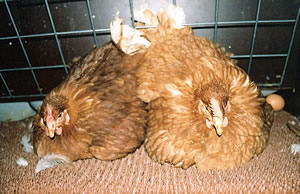
Any free range producer, who has struggled over the years to get his system working well, is sure to have learnt that to fix one problem usually creates another. John Widdowson suspects this might be the case with the increasing incidence of broodiness. "When we had nests with mesh floors and a wind howling through them, we rarely saw a broody chicken," said John. "Mind you most of the eggs were laid on the floor as well!" added John, who was quick to admit the broody problem was a small price to pay for the improved efficiency of the automatic type nest. Never the less, it is a nuisance, particularly with spring and summer housed flocks. John’s answer now is a pen constructed over the slatted floor, including a section of feed track and drinker, thereby reducing the chore of separate feeding and watering. In here the culprits will stay for between one and two weeks before resuming lay, and in the worst case, may be housing two per cent of the flock.
The Ranger asked Professor Peter Sharp of Roslin Institute, who is something of an expert on the subject, for his opinion. "It is likely to become more of a problem as systems where the hen can express nesting behaviour become more common. The urge is thwarted in cages and it is one of the factors that contribute to the efficiency of this system," said Peter. "It is a most undesirable trait that results in the regression of the ovary and lost egg production. Breeding programmes may select against the incidence of broodiness, although the heritability is low, but selection may slow the rate of progress towards improved production characteristics," said Peter. "However, selection for improved rate of lay may inadvertently reduce the chance of broodiness."
Professor Sharp went on to explain the physiological background to broodiness. "Increasing day length will usually bring the bird into breeding condition, and the developing ovary produces increasing amounts of the steroid hormone oestrogen. In addition to stimulating the development of the oviduct in preparation for egg formation, it acts on the brain to induce behavioural changes," said Peter. These changes include ’squatting’ to allow copulation, and nesting behaviour. The latter behaviour develops as the bird comes into lay, and is induced by an interaction within the brain between oestrogen and a second ovarian steroid hormone, progesterone.
In laying fowl, nesting behaviour begins just before an egg is laid and enables the bird to anticipate the forthcoming event and be at her chosen nest site rather than laying randomly on the floor. "After the chicken has been laying for a few weeks there is a tendency for nesting behaviour to become prolonged and this may eventually become so persistent that it is transformed into broodiness," Peter explained. A major factor in this transformation is tactile stimulation of the brood patch (the area on the breast, which would eventually lose all the feathers so that any eggs being incubated are actually in contact with the skin). With modern nesting boxes designed to remove the eggs, it is the floor of the nest that can provide this stimulation. This in turn causes the secretion of the hormone prolactin from the pituitary gland, and it is the high level of prolactin in the blood that maintains the state of broodiness.
It is recognition of the important role of prolactin in the incidence of broodiness that has led to the development of products that can be used to vaccinate the bird against broodiness. "Although at this stage the hens would need to be vaccinated about every three weeks to prevent the production of prolactin, which would not be practical, it may be that the product could be developed for oral administration. This would obviously be dependant on how big a problem broodiness is to the egg industry," said the Professor.
Until such time, the advice is to remove the birds from the nest, they are most easily recognised towards the end of the day where they may congregate together, and place in a pen where nesting is uncomfortable. The earlier in lay this is done, the more effective it will be, for research has shown that if treatment is applied later in the laying period, when the rate of lay is decreasing, it may result in a prolonged or even a permanent inhibition of egg production.
